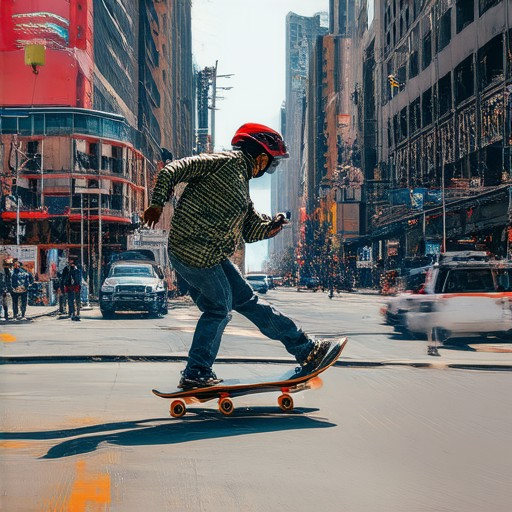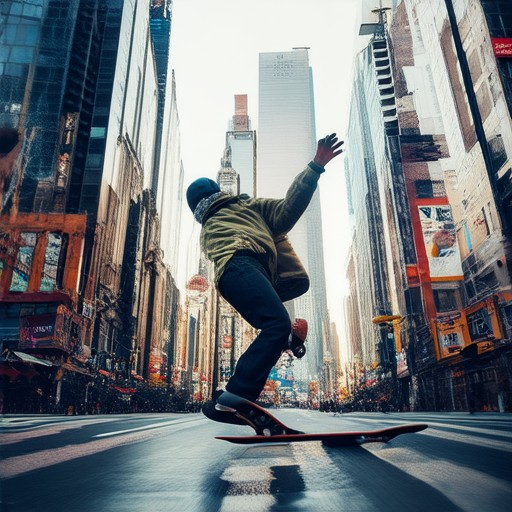Skateboarding has become a beloved pastime for many, offering a unique way to navigate urban environments with style and speed. While the thrill of gliding through city streets and parks is undeniably exciting, it’s essential to understand the ins and outs of skateboarding in such dynamic settings. Whether you’re a seasoned skater or new to the game, knowing the ropes—both legally and safely—is key to enjoying this exhilarating activity responsibly. From figuring out where you can skate to understanding the risks involved, this guide dives into the nuances of skateboarding in urban spaces, providing insights that every skater should know.
Key Takeaways
- Skateboarding is restricted due to safety concerns, property damage, and regulatory issues.
- Street skateboarding poses significant risks, including traffic accidents, falls, and legal consequences.
- Skateparks help reduce crime, foster community engagement, and promote safety.
- Always find safe, designated areas like skate parks to avoid penalties and risks.

Is It Legal To Skateboard On The Street?
Skateboarding on the street is generally permitted in many urban areas, but regulations may vary depending on your location and local laws. In California, for instance, state law allows skateboarders to use roads, though this can differ between cities.
General Rules
- Most cities allow skateboarders on public roads, but always check local ordinances for specific restrictions.
- Some areas may require skateboarders to stay off certain roads or paths, especially during peak hours or in busy zones.
- Skateboarding on sidewalks is often encouraged as a safer alternative to streets.
Exceptions
- Some cities prohibit skateboarding on certain roads, such as highways or major thoroughfares.
- Private property, like malls or apartment complexes, usually bans skateboarding without permission.
- Skateboarding on public transportation platforms or train tracks is illegal and dangerous.
Safety Considerations
- Always wear protective gear, including helmets and knee pads, to minimize risks.
- Respect traffic rules and yield to pedestrians and vehicles.
- Avoid skating at night or in low-visibility conditions.
Equipment Requirements
- Many cities require skateboarders to wear helmets, and some mandate knee pads as well.
- Check local laws for specific equipment requirements before hitting the streets.
For more detailed information on skateboarding laws and safety guidelines, visit our Skateboarding Laws Guide .
Remember to always respect local regulations and prioritize safety when skateboarding on public roads.
Is Skateboarding an Urban Sport?
Skateboarding is widely recognized as an urban sport due to its deep-rooted connection with city environments and the unique ways it utilizes public spaces. Here’s why skateboarding is considered an urban activity:
- The sport relies heavily on urban infrastructure, such as public benches, staircases, curbs, and railings, which provide the necessary features for tricks and maneuvers.
- Skateboarding has evolved alongside urban development, becoming a popular pastime in densely populated areas where open spaces are limited but creative expressions are abundant.
- It fosters a strong community ties, as skaters often gather in shared public spaces like skateparks or city streets to practice and socialize.
- Skateboarding encourages adaptability and innovation, as participants must navigate and utilize the existing features of urban landscapes, rather than relying on traditional sport facilities.
- Historically, skateboarding emerged in the late 1940s and 1950s in Southern California, closely tied to surf culture and the urban environment of beachside neighborhoods.
Skateboarding shares similarities with other urban sports like parkour and street basketball, as it thrives in the dynamic and fast-paced atmosphere of city life. Its ability to adapt to the unique characteristics of urban environments makes it a quintessential urban activity, deeply embedded in the culture and identity of many cities worldwide.

Can You Skateboard in the City?
Yes, you can skateboard in the city, but it’s important to do so responsibly and in accordance with local laws and regulations. Skateboarding in urban areas requires careful consideration of safety, legal restrictions, and shared pathways with pedestrians and vehicles.
Legality and Regulations
Skateboarding on public roads or sidewalks is typically prohibited in many cities due to safety concerns and traffic regulations. Many urban areas require skateboarders to use dedicated skate parks or bike lanes when navigating through the city.
Safety Considerations
- Always wear protective gear, including helmets and knee pads.
- Be aware of your surroundings and yield to pedestrians and vehicles.
- Stay off roads and sidewalks to reduce accident risks.
- Skateboarding in bike lanes is often the safest option in urban areas.
Best Practices
- Respect local signage and traffic rules.
- Find designated skate areas or park paths whenever possible.
- Avoid skating near heavy traffic or blind spots.
- Consider using public transportation or skate parks for safer enjoyment.
Local Laws and Permits
Some cities may require permits or specific areas for skateboarding. Check local regulations before heading out to ensure compliance and avoid fines or penalties.
Resources and Further Information
For more information on skateboarding in the city, visit our website or explore local skate shops and community centers for updated guidelines and resources.
By following these tips, you can enjoy skateboarding in the city safely and legally while contributing positively to the urban environment. Always prioritize safety and respect for others while sharing the streets.

Why is Skateboarding Illegal in Some Places?
Skateboarding can be restricted or banned in certain areas due to several factors:
- Safety Concerns: The act of skateboarding involves high-speed maneuvers and potential falls, posing significant risks of injury. Authorities may impose restrictions to minimize accident risks and legal liabilities.
- Property Damage: Skateboards can damage surfaces like sidewalks and curbs, leading to repair costs for municipalities. This can result in bans in areas where such damage is a concern.
- Vandalism Charges: In some cases, skateboarding is viewed as a form of vandalism, particularly when it involves intentional damage to public property, leading to stricter enforcement measures.
- Regulatory Issues: Local regulations may require permits or licenses for skateboarding in certain zones, and failure to comply can result in fines or bans.
- Noise Pollution: The noise generated by skateboard wheels on pavements can be disruptive, contributing to community complaints and leading to restrictions on where and when skating is allowed.
- Gangs and Delinquency: Skateboarding has sometimes been associated with gang activities or delinquent behavior, prompting law enforcement to impose stricter rules in affected areas.
Dangers of Skateboarding in the Street
Skateboarding on the street poses numerous risks that can lead to serious harm. Here are the primary dangers:
- Traffic Hazards: Skateboards are not designed for street surfaces, increasing the risk of accidents with cars, buses, and motorcycles. skateboarders may not be visible to drivers, leading to potential collisions.
- Falling Risks: Even experienced skateboarders can lose balance and fall, especially on uneven surfaces. Falls can result in head injuries, fractures, or other traumatic injuries without proper protection.
- Legal Consequences: Many cities and towns have laws prohibiting skateboarding on public roads. Violations can result in fines, tickets, or board confiscation.
- Poor Infrastructure: Sidewalks are not built for skateboarding, leading to discomfort, potential damage to equipment, and increased wear on the skateboard.
- Environmental Impact: Skateboarding on the street contributes to noise pollution and can disturb residents. It is often prohibited to maintain community standards and safety.
- Risk to Pedestrians: Speeding skateboarders may collide with pedestrians, causing injuries to both parties. This makes the activity particularly hazardous in crowded areas.
Always respect local regulations and find safe, designated areas to skate, such as skate parks or permitted locations. Wearing protective gear and following safety guidelines can significantly reduce risks.

Do Skateparks Reduce Crime?
A well-designed skatepark can have several positive effects on a community, including reducing crime rates. According to the THF Police Study , which analyzed the impact of public skatepark development, 47% of officers reported a decrease in overall youth crime following the opening of a skatepark. This reduction is attributed to several factors:
Community Engagement
Skateparks often serve as gathering spots for young people, fostering a sense of belonging and reducing the likelihood of antisocial behavior. By providing a safe and regulated space for skateboarding, communities can channel energy into constructive activities rather than negative ones.
Economic Impact
Beyond crime prevention, skateparks contribute to local economies by attracting visitors and increasing foot traffic. This can lead to improved retail sales and small business growth, further deterring criminal activity in the area.
Reduced Delinquency
Studies indicate that participation in physical activities like skateboarding correlates with lower rates of delinquency among youth. The structured environment of a skatepark encourages discipline and responsibility, which can translate into better behavior in school and society.
Public Safety
Skateparks equipped with proper supervision, lighting, and security measures create a safer environment for both participants and bystanders. This visibility can discourage potential criminals and foster a perception of safety within the community.
Design Considerations
To maximize crime-reduction benefits, skateparks should be designed with features that encourage community involvement and oversight. Features like open layouts, shaded areas, and seating can make the park more appealing and welcoming to families and locals.
Conclusion
Overall, skateparks play a crucial role in reducing crime by providing a safe, inclusive space for youth and fostering stronger community ties. Local governments and organizations should consider the long-term benefits of investing in quality skateparks to create a more harmonious and resilient neighborhood.




0 Comments